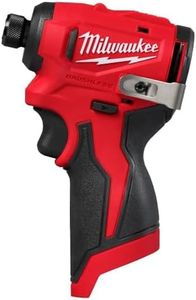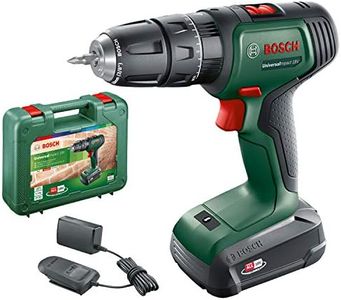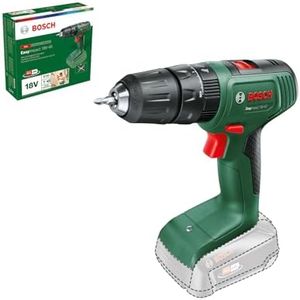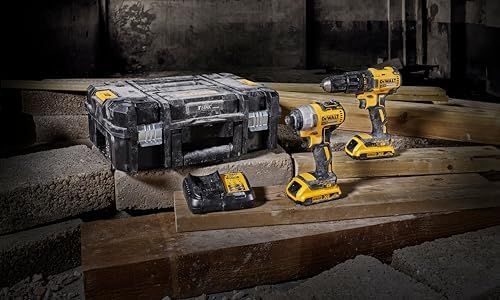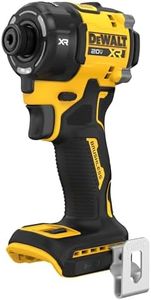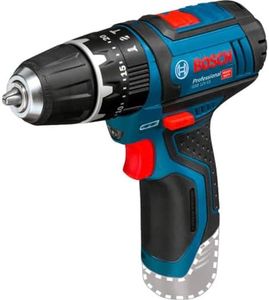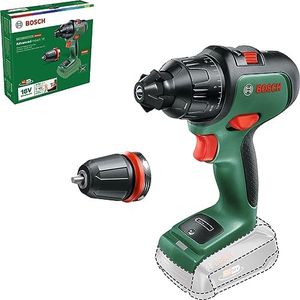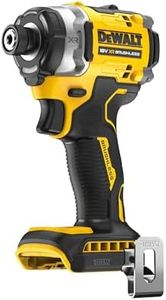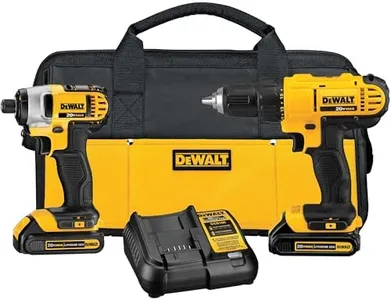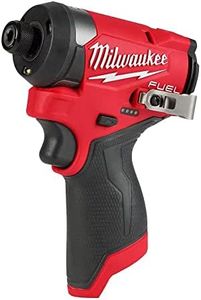We Use CookiesWe use cookies to enhance the security, performance,
functionality and for analytical and promotional activities. By continuing to browse this site you
are agreeing to our privacy policy
10 Best Cordless Impact Drills
From leading brands and best sellers available on the web.Buying Guide for the Best Cordless Impact Drills
Cordless impact drills are versatile power tools designed for driving screws and drilling holes, especially into tougher materials like masonry or metal. When picking the right one for you, think about what types of projects you’d like to tackle—are you planning on heavy-duty renovations, assembling furniture, or just light home repairs? It’s important to understand what each specification means and how it relates to what you want to achieve. Comparing key features can help you identify a drill that not only gets the job done but does it comfortably and efficiently.Voltage (Battery Power)Voltage measures the power output of your cordless drill’s battery. This directly impacts how much force the drill can deliver: higher voltage means more power for tough tasks. Entry-level drills usually offer around 12V, which is suitable for light tasks like furniture assembly and small repairs. Mid-range options provide 18V to 20V, ideal for most home projects and some tougher jobs. Heavy-duty work often calls for 24V or even more, but these are typically heavier and may be overkill for casual use. Think about your typical projects: if you mostly plan light, indoor tasks, a lower voltage will keep the drill lighter and easier to handle. For regular work on hard materials or renovation projects, aim for the mid to high voltage segment.
TorqueTorque is the turning force the drill can produce, which is especially important when you're driving large screws or working with resistant materials. It’s usually measured in Newton-meters (Nm). Lower torque (under 30 Nm) is fine for basic household jobs, while moderate torque (30–60 Nm) works for most medium-duty needs. High torque (over 60 Nm) is often needed for construction tasks or working with dense materials. Consider your workload: heavy-duty users benefit from higher torque, while for occasional home use, a lower value is easier to control and sufficient for most needs.
Battery Type & CapacityMost modern cordless drills use lithium-ion (Li-ion) batteries, known for being lightweight, quick to charge, and long-lasting. Battery capacity, measured in ampere-hours (Ah), affects how long the drill can operate between charges. Lower capacities (1.0–1.5 Ah) are okay for quick or infrequent tasks. A medium capacity (2.0–3.0 Ah) offers a balance between size and runtime, making it great for regular household use. Higher capacities (above 3.0 Ah) are best for extended or demanding tasks but add extra weight. If you often work on longer projects or don’t want frequent recharging, look for higher Ah. For quick, occasional jobs, a lower capacity keeps the tool lighter.
Speed (RPM) & Speed SettingsSpeed, measured in revolutions per minute (RPM), is the rate at which the drill bit rotates. Many drills offer variable speed settings, allowing you to adjust for precision tasks (lower speeds) or fast drilling (higher speeds). Low speeds (0–500 RPM) are suitable for driving screws, while high speeds (1,200+ RPM) excel at drilling holes. Some drills allow you to switch between two or more speed ranges, which is great if you’ll use your drill for both fastening and drilling. Choose a drill with multiple speed settings if you want versatility; if your tasks are always the same, a single-speed drill may suffice.
Chuck Size and TypeThe chuck is the part of the drill that holds the bit. Common sizes are 3/8 inch (10mm) and 1/2 inch (13mm). A larger chuck can handle bigger bits, making the drill more versatile for larger holes and heavier-duty applications. For light jobs and smaller bits, a 3/8-inch chuck is usually enough. If you expect to use your drill for a variety of tasks, or with larger accessories, look for a 1/2-inch chuck. Keyless chucks (opened and closed by hand) are more convenient, allowing quick bit changes without extra tools, while keyed chucks offer a bit more grip but are slower to use.
Weight and ErgonomicsThe weight and feel of the drill matter—especially if you’ll be using it for long periods or overhead tasks. Lighter drills reduce fatigue during prolonged use, while a comfortable grip and well-balanced design make control easier and improve safety. If you have smaller hands or foresee long working sessions, prioritize ergonomics and lighter models. Try holding the drill before buying, if possible, to ensure it feels right for you.
Impact FunctionAn impact drill adds a hammering action on top of the spinning motion, allowing it to drill into tougher materials like brick or concrete. Not all cordless drills have this function. If your work involves masonry, tiles, or other hard surfaces, ensure the drill offers an impact mode. For general woodworking or light repairs, this feature may not be necessary and could add to the drill’s weight.


